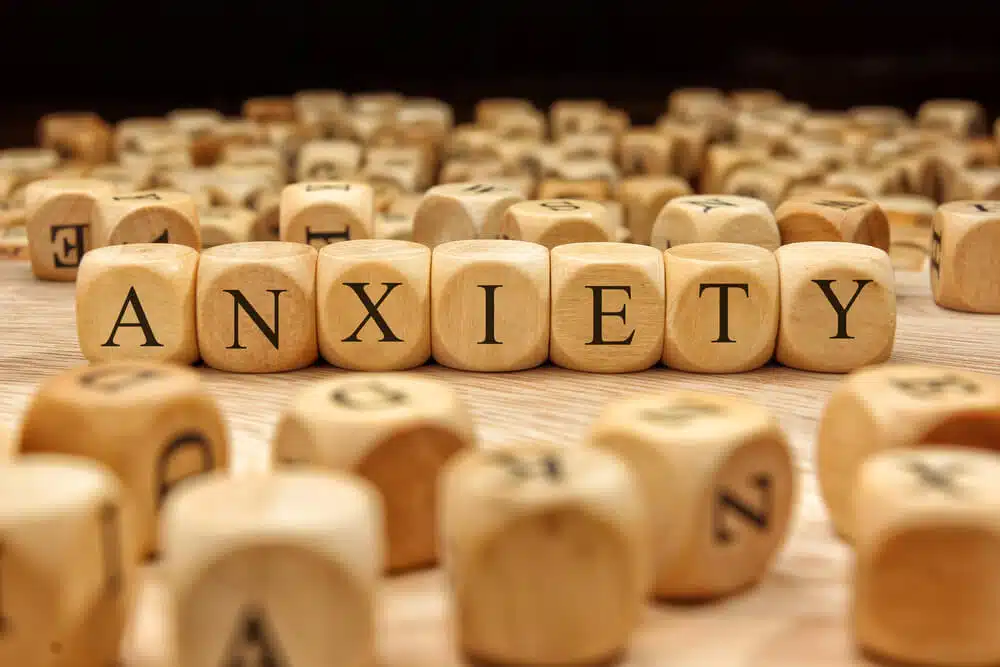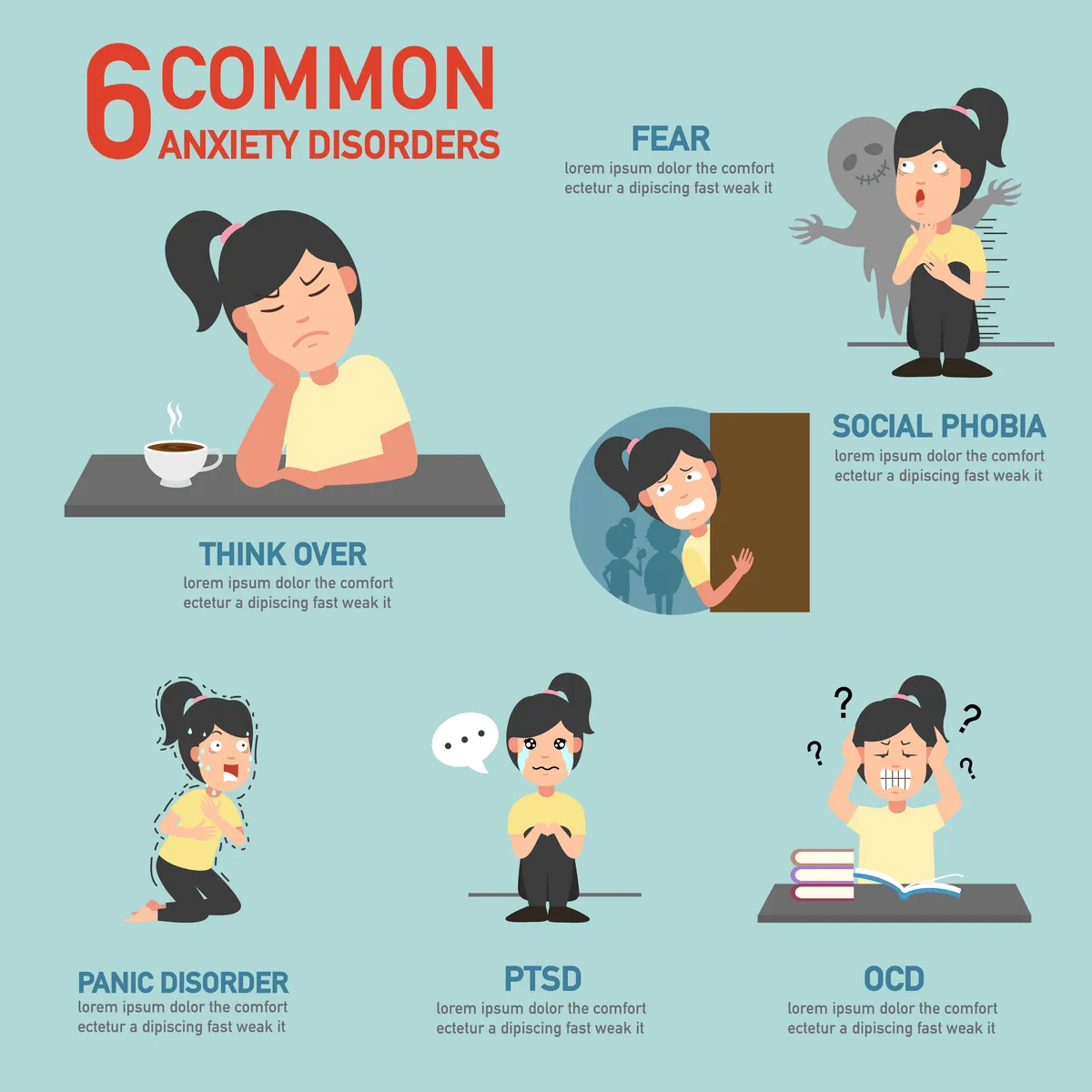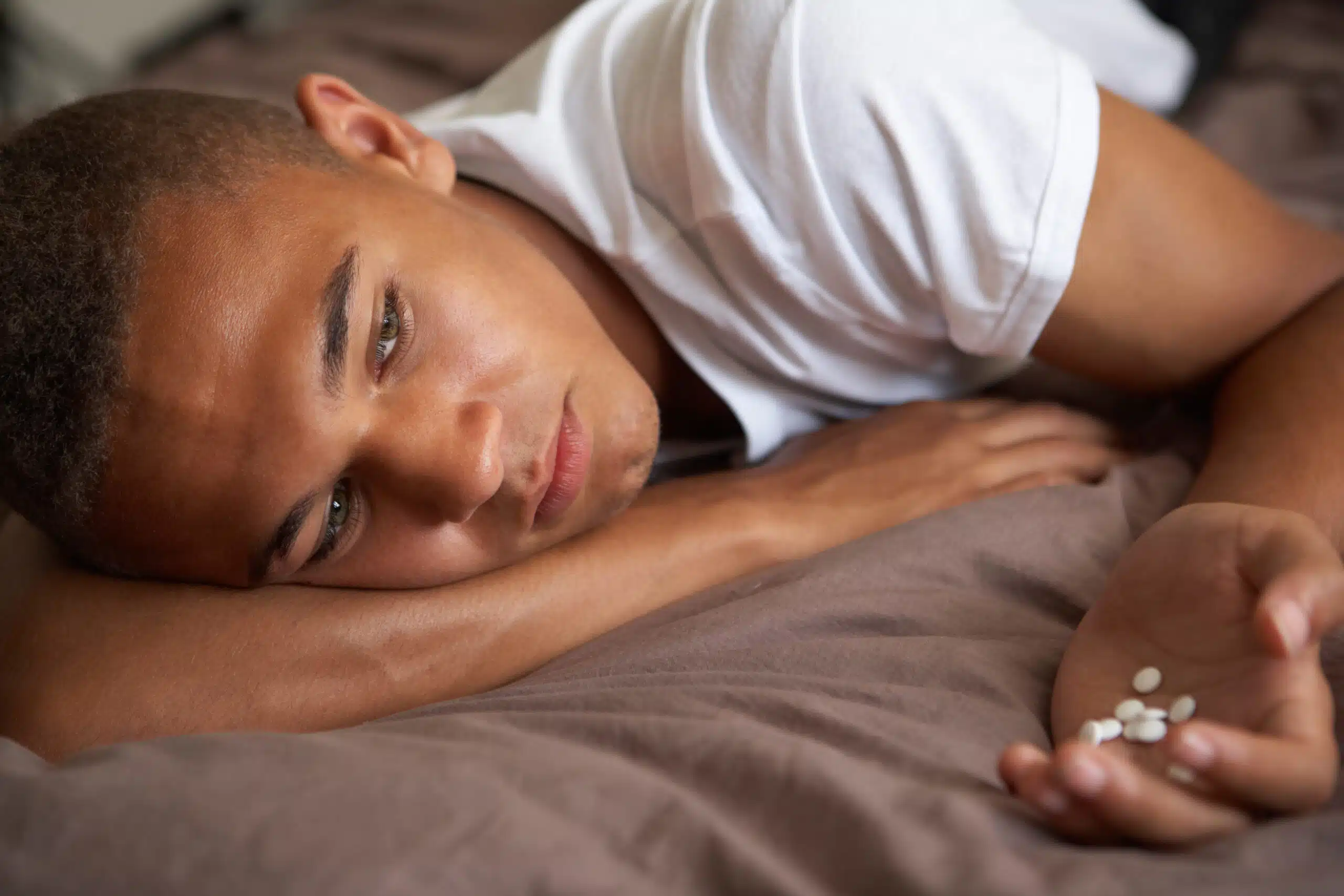
What Are the Six Types of Anxiety Disorders?
What Are the Six Types of Anxiety Disorders?
When you think of anxiety, you may not realize that there are multiple anxiety disorders. While the most common of the disorders is what’s known as Generalized Anxiety Disorder (GAD), there are five other distinct types of anxiety disorders you can be diagnosed with, each with its own unique features.
The key feature of all anxiety disorders is, of course, the presence of anxiety – a general feeling of anxiousness and unrest, with possible feelings of paranoia or accompanying depression. But those are just the tip of the iceberg when it comes to the overall signs and symptoms for all anxiety disorders.
It’s essential to educate yourself about the variety of anxiety disorders to ensure that you are properly diagnosed and receiving appropriate treatment. The six types of anxiety disorders include GAD, social anxiety, phobias, panic disorder, obsessive compulsive disorder (OCD), and post-traumatic stress disorder (PTSD).
Generalized Anxiety Disorder
Generalized anxiety disorder has symptoms similar to panic disorder, obsessive-compulsive disorder, and other types of anxiety, but each is a different condition.
Living with generalized anxiety disorder is challenging. It usually occurs alongside other anxiety or mood disorders. Frequently, generalized anxiety disorder improves with psychotherapy and/or medications. A therapist can help you make appropriate lifestyle changes, learn new coping skills, and learn to use relaxation techniques.
Generalized anxiety disorder symptoms can vary:
- Persistent worrying or anxiety out of proportion to events
- Overthinking plans and solutions to worst-case scenarios
- Perceiving situations and events as threatening
- Difficulty managing uncertainty
- Indecisiveness and fear of making wrong decisions
- Inability to set aside or let go of a worry
- Inability to relax, feeling restless, and feeling on edge
- Difficulty concentrating or the feeling that your mind “goes blank”
- Fatigue and irritability
- Trouble sleeping or going to sleep
- Muscle tension or muscle pain
- Sweating
- Trembling, feeling twitchy
- Nervousness or being easily startled
- Nausea, diarrhea, or irritable bowel syndrome
One of the worst features of any anxiety disorder is when there’s no apparent reason for anxiety, yet you feel it anyway. You could feel intense worry about your safety, threats to your loved ones, or a general feeling that something bad is about to happen.
Your anxiety, worry or physical symptoms cause you significant distress in many areas of your life. Worries can shift back and forth and can constantly change. The nature of the worries is open to anything in your life. Generalized anxiety is tough to deal with as an adult, but it is worse for teens.
Teenagers may have similar worries to adults, but also may have other excessive worries:
- Performance in school or sports
- Family members’ safety
- Being on time
- Earthquakes, nuclear war, or other catastrophic events
- Feel overly anxious to fit in
- Perfectionism
- Spend excessive time doing homework or another self-improvement activity
- Lack confidence, yet strive for approval
- Require a lot of reassurance
- Have frequent stomachaches or other physical maladies
- Avoid going to school or other social situations
Generalized anxiety disorder is just the tip of the anxiety iceberg. Many teens not only have GAD, but they are also prone to social anxiety.
Social Anxiety
Social anxiety disorder is one of the most common of the anxiety disorders. “A person with social anxiety disorder feels symptoms of anxiety or fear in certain or all social situations, such as meeting new people, dating, being on a job interview, answering a question in class, or having to talk to a cashier in a store. Doing everyday things in front of people—such as eating or drinking in front of others or using a public restroom—also causes anxiety or fear. The person is afraid that he or she will be humiliated, judged, and rejected.”
People with social anxiety disorder feel completely out of control. They feel like they cannot control either the situation or their reaction to it. So, this anxiety negatively effects going to work, going to school, or doing daily tasks. People with social anxiety disorder worry about things for days and weeks before they occur. Sometimes, they end up staying away from places or events to avoid behaving in an embarrassing way.
Social anxiety disorder usually stems from shyness during youth. Social anxiety disorder is fairly common, but without treatment, social anxiety disorder can last for years or a lifetime. It can reach levels where it prevents someone from achieving his or her full potential.
People with social anxiety disorder tend to
- Blush, sweat, tremble, have a racing heart, or feel their “mind going blank”
- Feel sick to their stomach
- Show a rigid body posture, make little eye contact, or speak very softly
- Find it scary and difficult to be with other people, especially strangers
- Be very self-conscious in front of other people, feeling mortified and awkward
- Be very afraid of judgment
- Stay away from highly populated places
Researchers have discovered that multiple parts of the brain are engaged in anxiety. Other researchers think that a person’s misreading of others’ behavior can cause or worsen social anxiety. Immature social skills are also a possible contributor to social anxiety.
GAD and social anxiety are both fairly common, but so are phobias.
Phobias
A phobia is an exaggerated and irrational fear. Most people have some kinds of fears in their lives – like spiders, snakes, heights, etc. However, American Psychiatric Association (APA) recognizes three types of phobia:
Specific phobia: This is a powerful, irrational fear of a specific trigger. For example, some people are so frightened of spiders that they will run from the room screaming if they see even the smallest spider.
Social phobia: This is a profound fear of public humiliation or being unfairly judged by others. The idea of large social gatherings is terrifying for someone with social anxiety and they often cannot relax until they leave the gathering or event. There are people who experience shyness, but they tend to be able to get comfortable in large groups within a matter of minutes.
Agoraphobia: This is a fear of situations from which it would be difficult to escape. It is commonly misunderstood as a fear of open spaces or a fear of the outside world, but it can also apply to being confined in a small space (aka claustrophobia), or being on public transportation (unable to get on a public bus or subway or train). People with agoraphobia also have a heightened risk of panic disorder.
Specific phobias are also known as simple phobias since they can be linked to an identifiable cause – one that may not frequently occur in the everyday life. These are not likely to affect day-to-day living in any significant way. For instance, if you are afraid of snakes and live in the city, you aren’t likely to run into a snake anytime soon.
Social anxiety and agoraphobia are known as complex phobias, as their triggers are hard to recognize. People with complex phobias find it harder to avoid triggers. Attending regular events like church or going to college can easily trigger a panic attack for those with agoraphobia or social anxiety.
People with phobias have an overpowering need to avoid their triggers. They don’t want to slip into a panic attack. For others, say those living with panic disorder, daily life is far worse.
Panic Disorder
Panic disorder exists in people who experience spontaneous, unprovoked panic attacks and are extremely worried about a recurring attack. Panic attacks occur unpredictably, sometimes even when a person is waking up from sleep. Panic disorder can interfere with daily life, causing people to miss work, go to an excessive number of doctor visits, and avoid situations that provoke a panic attack.
A panic attack is the abrupt onset of “intense fear or discomfort that reaches a peak within minutes” and shows at least 4 of the following symptoms:
- Pounding heart, or accelerated heart rate
- Fear of dying
- Sweating, trembling, or shaking
- Sensations of shortness of breath or smothering
- Chills or hot flashes
- Feelings of choking
- Chest pain or discomfort
- Nausea or abdominal distress
- Feeling dizzy, light-headed, or faint
- Numbness or tingling
- Feelings of unreality or being detached from oneself
- Fear of losing control or “going crazy”
Although panic attacks are often accompanied by physical symptoms, a panic attack is different from other anxiety indicators because of the intensity and duration of the symptoms. Panic attacks typically reach their peak in 10 minutes or less and then start to abate. Due to the intensity of the symptoms, and their similarities with other conditions, patients with panic disorder take lots of trips to emergency rooms or doctors’ offices, convinced they are having a heart attack or some other life-threatening event.
Panic attacks can happen either during a calm state or an anxious state. Panic attacks are fairly nasty and terrifying. As a result, people with panic attacks often make changes to their lifestyle to avoid having panic attacks. Changes in lifestyle can be extremely helpful for those with panic disorder and also for those with obsessive compulsive disorder.
Obsessive Compulsive Disorder
Obsessive-compulsive disorder (OCD) is an anxiety disorder in which patients have “recurring, unwanted thoughts, ideas or sensations (obsessions) that make them feel driven to do something repetitively (compulsions). The repetitive behaviors, such as hand washing, checking on things or cleaning, can significantly interfere with a person’s daily activities and social interactions.”
Many people with OCD have hyper focused thoughts or repeated, intense behaviors. The thoughts are persistent and undesirable routines are rigid. Not acknowledging and/or participating in these activities will cause patients great distress. There are lots of patients with OCD who know or suspect their obsessions are unfounded; there are also patients who may think they could be true. Even if a patient knows their obsessions are not true, they have difficulty keeping their focus off the obsessions or stopping the compulsive behaviors.
Those with diagnosed OCD have at least one obsession and/or compulsion that is time-consuming (more than 60 minutes daily), causes major distress, and impairs daily function.
Obsessions are frequent and persistent thoughts, impulses, or images that cause disturbing emotions. Many people with OCD recognize that the thoughts, impulses, or images are unnecessary or irrational. But, these intrusive thoughts cannot be stopped with logic or rational thinking. Most people with OCD try to ignore or stifle these obsessions. Typical obsessions include the following: excessive worry about contamination or harm, a need for symmetry or exactness, or obsessive alphabetization and organization.
Compulsions are repetitive behaviors that a person feels driven to perform in response to an obsession. The behaviors are meant to prevent distress or avoid a dreaded situation. In the most troubling cases of OCD, this constant recurrence of rituals may fill the day, making it impossible for the patient to carry out a normal routine. So, the compulsions are reactions to the obsessive thoughts of the mind. Some examples of compulsions include the following:
- Cleaning to reduce the fear that germs, dirt, or chemicals will “contaminate” them
- Repeating to dispel anxiety. Some people utter a name or phrase or repeat a behavior several times
- Checking to reduce the fear of harming oneself or others by, for example, “forgetting to lock the door or turn off the gas stove, some people develop checking rituals. Some people repeatedly retrace driving routes to be sure they haven’t hit anyone”
- Ordering and arranging to reduce discomfort
- Silently praying or saying phrases to reduce anxiety or prevent a dreaded future event
The most frustrating part of OCD is that the patient knows the obsessions and compulsions are not logical – they have no real root. This is the opposite of post-traumatic stress disorder, where the cause is only too obvious.

Post-Traumatic Stress Disorder
Post-Traumatic Stress Disorder (PTSD) may develop after exposure to an event or ordeal where “death or severe physical harm occurred or was threatened. People who suffer from the disorder include military troops, rescue workers, and survivors of shootings, bombings, violence, and rape. Family members of victims can develop the disorder as well through vicarious trauma.”
PTSD is diagnosed when stress symptoms and anxiety following exposure persist for more than a month. While PTSD has traditionally been attributed to military men and women who’ve seen combat, PTSD knows no gender, no age, no race, no religion, no culture – everyone is susceptible to it.
Lots of patients with PTSD tend to re-experience the traumatic event, especially when they are exposed to triggers. Anniversaries of an event and similarities in person, place, or circumstance can trigger symptoms. For instance, if a person survived a school shooting, returning to that school or being surrounded by people from that school can trigger an episode of extreme anxiety.
People with PTSD must deal with anxiety, intrusive memories, sleep disturbances, flashbacks, emotional numbness, intense guilt, irritability, sadness, outbursts of anger, and dissociative experiences. Many patients diagnosed with PTSD try to avoid conditions that remind them of the traumatic event.
Symptoms of PTSD include the following:
- Bad dreams or distressing memories
- Flashbacks
- Dissociative reactions or loss of awareness of present surroundings
- Experiencing intense emotions when reminded of the event
- Avoiding thoughts, conversations, feelings, people, activities, or places associated with the event
- Trouble falling or staying asleep
- Irritability and outbursts of anger
- Difficulty concentrating
- Easily startled or excess awareness (hypervigilance)
- Depersonalization (feeling like an observer to one’s body and thoughts/feelings) or derealization (experiencing unreality of surroundings)
- Having difficulty remembering an important part of the original trauma
- Feeling numb
- Lack of interest in social activities
- Inability to experience positive moods
- Pessimism about the future
PTSD is an anxiety disorder that truly affects the ability of a person to go about daily living. Having it properly diagnosed and treated is essential.
Conclusion
These six types of anxiety disorders have two things in common: worry and fear. It can be said that worry and fear are the basis for all types of anxiety, but in each disorder, the intensity and persistence of worry and fear determine how the person will react in their anxiety.




